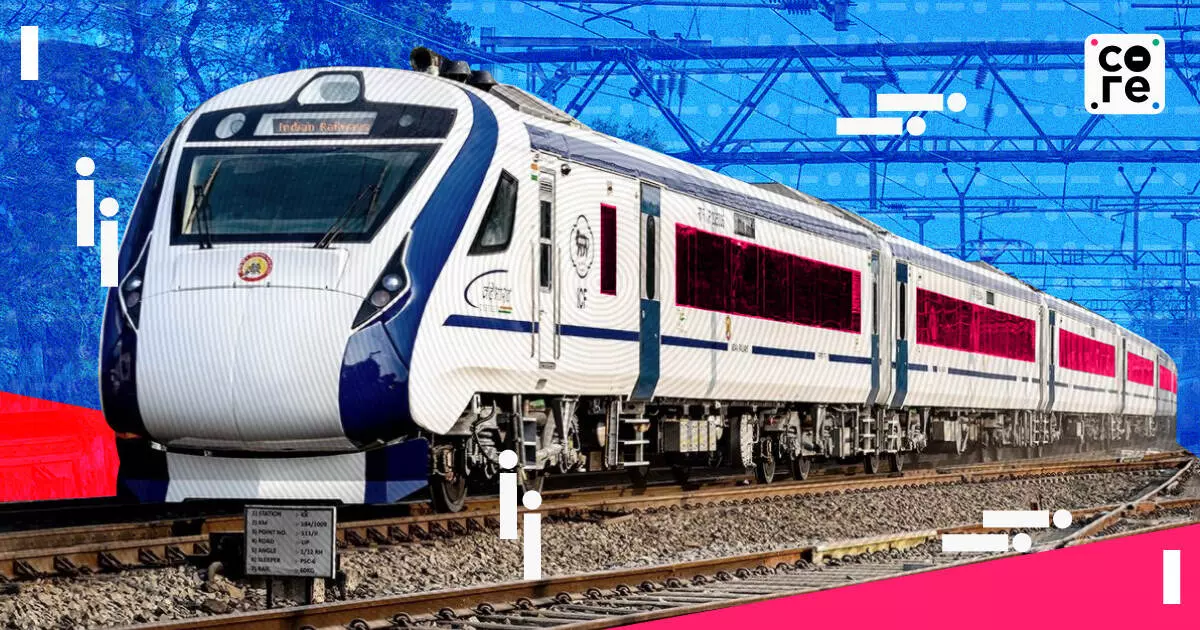
Why India’s High-Speed Ambitions Aren’t ‘On-Track’
India has semi-high-speed trains that can potentially cut travel times substantially, but the lack of necessary allied infrastructure is holding them back.

India’s tryst with high-speed trains has been in public discourse for decades. We saw some green shoots when Vande Bharat Express trains were launched in 2019. But even today, by international standards, India’s high-speed trains are semi-high speed at best, according to Sudhanshu Mani, who served as general manager at Indian Railways' Integral Coach Factory and is also credited as the mastermind behind the Vande Bharat Express train.
“High speed is a term loosely used, and there are various definitions ranging from speeds above 200 km/hr to above 250 km/hr, I would place it more like at least above 220 km/hr,” Mani told The Core.
Currently, the fastest trains in India are the Vande Bharat Express from Delhi to Varanasi and the Gatimaan Express that connects Delhi and Jhansi. These trains have been tested to run at 180 km/hr but are commercially cleared only to run at 160 km/hr.
Recently, this was further reduced to 130 km/hr amid safety concerns as the Train Protection & Warning System (TPWS) on certain routes malfunctioned leading to multiple fatal accidents.
Other Vande Bharat Express trains like those on the Mumbai-Shirdi route in Maharashtra have average speeds as low as 64 km/hr. The overall average speed of Vande Bharat trains in the country was 83 km/hr as of April last year.
But what’s causing trains that have been tested to run at 180 km/hr to run at much lower speeds? It’s the lack of allied...
India’s tryst with high-speed trains has been in public discourse for decades. We saw some green shoots when Vande Bharat Express trains were launched in 2019. But even today, by international standards, India’s high-speed trains are semi-high speed at best, according to Sudhanshu Mani, who served as general manager at Indian Railways' Integral Coach Factory and is also credited as the mastermind behind the Vande Bharat Express train.
“High speed is a term loosely used, and there are various definitions ranging from speeds above 200 km/hr to above 250 km/hr, I would place it more like at least above 220 km/hr,” Mani told The Core.
Currently, the fastest trains in India are the Vande Bharat Express from Delhi to Varanasi and the Gatimaan Express that connects Delhi and Jhansi. These trains have been tested to run at 180 km/hr but are commercially cleared only to run at 160 km/hr.
Recently, this was further reduced to 130 km/hr amid safety concerns as the Train Protection & Warning System (TPWS) on certain routes malfunctioned leading to multiple fatal accidents.
Other Vande Bharat Express trains like those on the Mumbai-Shirdi route in Maharashtra have average speeds as low as 64 km/hr. The overall average speed of Vande Bharat trains in the country was 83 km/hr as of April last year.
But what’s causing trains that have been tested to run at 180 km/hr to run at much lower speeds? It’s the lack of allied infrastructure and safety measures.
What Are The Roadblocks?
There are two main reasons, track conditions, and signalling systems. To run at these high speeds, the rail tracks need to be upgraded and this hasn’t happened at the pace expected.
“Fencing of the tracks (is required), because the impact of any cattle getting run over is much higher on a higher speed. Improvement in overhead traction line is also needed,” Mani said.
India’s train signalling system is due for an upgrade and recent fatal accidents have further highlighted this need. Yet, the installation of Kavach, an automatic train protection (ATP) system, isn't fast-tracked.
India has trains that can potentially cut travel times substantially, but the lack of necessary allied infrastructure is holding them back. Once these factors are addressed, we may have substantial kilometres being able to support the 160 km/hr speeds. In these circumstances, having trains running at 220 km/hr across the country seems a distant dream so far.
What Do We Need Fast Trains?
One may argue why India needs such super fast in the first place. With air travel booming, it is clear that there is a need for public transport systems and fast trains are key to boosting economic growth too. However, air travel remains inaccessible for many Indians as it is expensive. Additionally, trains are considered a cleaner and greener alternative.
However, travel times are the biggest challenge. The comfort of the passengers has been more or less taken care of in both of these modes of transport, according to Mani. “For example, (from) Delhi to Bhopal, if you can bring it (travel time) down to, say, four and a half hours, then the advantage that air traffic has is lost, and people would prefer to travel in trains,” he said.
Where Are The Bullet Trains?
In its lofty plans for high-speed rail travel, India also has bullet trains on the board, running at targeted speeds of 250 km/hr. The Mumbai - Ahmedabad is the first route on the map and some progress has also been made. However, there have been delays and the train is expected to be operational only by 2029 with an estimated travel time of two hours 45 minutes.
Setting up bullet trains would require building more dedicated tracks. “When you build a dedicated track, then you cannot have too many curvatures. There are too many gradients because these are the impediments to speedy track, “ Mani said.
According to Mani, in the next five years, only the Mumbai-Ahmedabad bullet train plan is expected to materialise, and even the existing tracks wouldn’t be able to reach the capacity to run 200 km/hr trains.
India has semi-high-speed trains that can potentially cut travel times substantially, but the lack of necessary allied infrastructure is holding them back.

